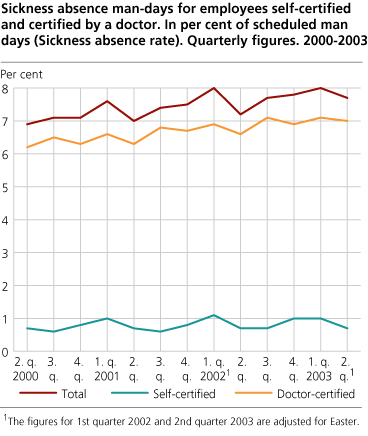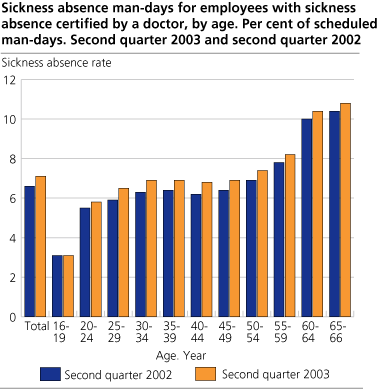Content
Published:
This is an archived release.
Sickness absence increased
The total sickness absence rate second quarter 2003 was 7,8. The total absence increased by 0.5 percentage points from the same quarter last year, 0.6 points for women and 0.3 for men. The sickness absence increased 0.2 percentage points the first half-year of 2003 compared to the same period the year before.
There are elements of uncertainty in the underlying development of the absence. Adjusted for seasonal changes, the yearly growth up to second quarter this year was relatively high, while the same growth in the first quarter figures was relatively low.
The figures of change are adjusted for the fact that Easter fell in the 1st quarter in 2002 and in the 2nd quarter in 2003. The increase in the sickness absence rate from the second quarter 2002 to the second quarter 2003 is calculated to drop from 0.6 to 0.5 percentage points if we did not take the Easter week into account.
No change in self-certified sickness absences
The doctor-certified sickness absence rate was 7.1 per cent, which is an increase by 0.5 percentage points. The self-certified absence rate remained stable at 0.7.
Extended right to self-certified absence
The share of establishments with the right to extended self-certified sickness absence was higher in the second quarter 2003 than the second quarter 2002. However, the figures for self-certified absence show no growth in this period.
Strongest increase in construction
The sickness absence in construction increased by 1.1 percentage points. There was also a considerable increase in transport and communication, financial intermediation, business activities and health and social services.
Increased share of elderly among employees
The decrease in employment the last year has been strongest among persons under 50 years of age. A higher share of elderly contributes to a higher sickness absence rate.
Strongest increase among women aged 25-34
The following comments are based on the figures for sickness absence certified by a doctor, which represents approximately 90 per cent of the total absence. The survey on self-certified absence does not include the variables age or county of residence.
The growth in the absence for men was lowest under 34 and over 60 years of age. Among women the growth was low in the age group of 50-54, while it was strongest for 25-34. The level of sickness absence is still highest in the oldest age groups for both men and women.
Growth in all counties
The increase in absence was strongest in Finnmark with 0.8 percentage points last year. Oslo and Aust-Agder had the lowest increase, 0.3 percentage points.
Finnmark had the highest absence rate, 9.0. Rogaland had the lowest rate, 5.4, and then Sogn og Fjordane with 6.2.
Sickness absence statistics in Statbank Norway
Statbank Norway is a service containing detailed statistics on the Internet containing sickness absence statistics by sex, age, industry and county of residence.
Tables:
- Table 1 Sickness absence man-days for employees self-certified and certified by a doctor. In per cent of scheduled man-days (Sickness absence rate). Quarterly figures. 2000-2003
- Table 2 Sickness absence man-days for employees self-certified and certified by a doctor, by sex. In per cent of scheduled man-days (sickness absence rate). Quarterly figures. 2000-2003
- Table 3 Sickness absence man-days for employees self-certified and certified by a doctor, by industry and type of sickness absence. In per cent of scheduled man days (sickness absence rate). Quarterly figures. 2000-2003
Contact
-
Arbeidsmarked og lønn
E-mail: arbeidsmarked@ssb.no
-
Unn H. Høydahl
E-mail: unnh.hoydahl@ssb.no
tel.: (+47) 40 90 23 77


